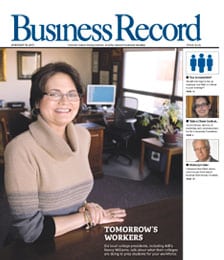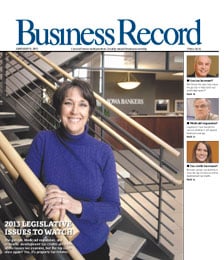G-RAD Systems automates soil testing process
How many Iowa State University professors does it take to help soil engineers work smarter in the field?
Just three, but it also required some assistance from the ISU Pappajohn Center for Entrepreneurship and a cool start-up name – G-Rad Systems.
Ed Jaselskis, an associate professor with ISU’s Department of Civil, Construction and Environmental Engineering, has collaborated with Russ Walters and David White, both assistant engineering professors, to develop a more efficient way for technicians to record data from a particular soil testing device at construction sites. They say their device can effectively double the productivity of a person conducting soil compaction testing and allow companies to make real-time decisions in the field.
Presently, technicians write down the testing data in the field and bring them back to a computer to crunch the numbers and draw up graphs. G-Rad’s device, which is basically a programmed handheld PDA, immediately performs the calculations and displays the results. A built-in Global Positioning System device also records the location of each test, which measures how many blows it takes to drive a standardized stainless steel rod into the soil.
“You might have to take 20 or 30 readings per test,” Walters said. “So this makes that piece of equipment (called a dynamic cone penetrometer) a lot more useful, because someone in the field can make a decision right away.”
Several companies are field-testing the product, and a Pennsylvania-based geotechnical testing company has already purchased one of the devices, which sell for $1,995 through a distributor. Additionally, the trio says they’re about a month away from debugging a refined version that will fully automate the process. The Iowa Department of Transportation plans to test both versions of the product on a major road construction project this fall in conjunction with a highway contractor.
“What that will do is provide the opportunity to get some good feedback, demonstrate the equipment and show people the advantages of it, so that’s going to be a big deal for us,” Walters said.
Using $2,000 in seed funding received from ISU two years ago, the partners hired a graduate student to help do the programming and develop a prototype. With assistance from the Pappajohn Entrepreneurial Center, they developed a business plan to form G-Rad, which stands for Geotechnical Remote Acquisition of Data, as a C corporation to license the technology from the university.
“The university also allows us consulting time to work on this company during work hours,” Jaselskis said. “The university really seems to encourage this kind of activity. They really want to see research go from an academic shelf out to be used in the market.”
Though the software program isn’t patentable, it’s possible they may pursue a patent on the automated version of the device with the university.
The partners estimate there are up to 3,000 dynamic cone penetrometers in use across the country, and that there is probably a market for that many new devices within the next several years. Potential markets include state transportation departments, military contractors and private testing companies.
Jaselskis said the measurement device is the first of many engineering applications the partners hope to bring to market through G-Rad. Though they have other projects on the drawing boards already, they say it’s too early to discuss them.
“One of the goals for the company is pursuing research contracts sponsored through the Small Business Innovation Research program,” Walters said. “What’s really neat is that we could bring in this research funding through the company and work with ISU and graduate students, and support other companies in Iowa to help us develop those technologies through that funding.”







